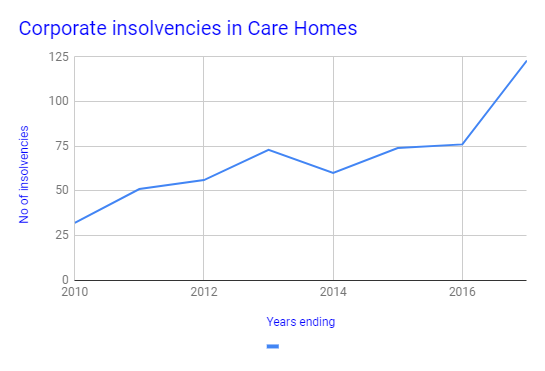Is the UK already in a care home crisis?
Care homes are struggling nationwide due to council fee income reductions and increased wage costs.
The most recent official insolvency figures released show a marked increase in the number of care home insolvencies over the last 15 months. We know that care homes are struggling nationwide, largely because of council fee income reductions coupled with increased costs brought on by regulatory changes and employee pay legislation.
Here we look at some of those cost increases, and examine what effect they are having on Care Home providers; specifically, at which providers are disproportionately disadvantaged by regulatory changes. We'll also take look at the longer term outlook for care homes as an industry.
National Living Wage
The national living wage is an obligatory minimum wage payable to workers in the United Kingdom which came into effect on 1 April 2016. It increased in April 2017, and from April 2018 has increased again. The increases are illustrated below:
| Age Group | April 2017 | April 2018 |
| National Living Wage (25+) | £7.50 p.h. | £7.83 p.h. |
| NMW (21-24) | £7.05 p.h. | £7.38 p.h. |
| NMW (18-20) | £5.60 p.h. | £5.90 p.h. |
| NMW (16-17) | £4.05 p.h. | £4.20 p.h. |
| Apprentice NMW | £3.50 p.h. | £3.70 p.h. |
Further increase are expected for 2019 and 2020, although the amounts have yet to be decided.
Auto-enrolment costs
Auto-enrolment was rolled out from 2016, but the amount employers pay in to the scheme doubled in April 2018, as per the table below. This will add an increase to 3% of the wage bill from April 2019.
| Date | Employer minimum contribution | Total minimum contribution |
| Before April 5 2018 | 1% | 2% (including 1% staff contribution) |
| April 6 2018 – April 5 2019 | 2% | 5% (including 3% staff contribution) |
| April 6 2019 onwards | 3% | 8% (including 5% staff contribution) |
The 'sleep-in' tribunal decision
In April 2017, the Employment Appeal Tribunal in Royal Mencap Society Vs Tomlinson- Blake came to the decision that all care staff should have been paid minimum wage when they slept over either for domiciliary care or at care homes. Historically, staff were paid a significantly reduced amount for their 'asleep hours', but the tribunal took the view that this was legally incorrect, and they are entitled to minimum wage or National LIving Wage as it is now for all hours at work, regardless of whether asleep or not.
HMRC followed this stating that firms should pay staff dating back 6 years from the decision. This means that care homes and domiciliary businesses have an estimated £400 million to find to cover back pay, and an increased wage bill of over £200 million per annum moving forward. The government temporarily stayed enforcement, but it now looks like all arrears must be brought up to date by March 2019.
What does it mean?
Firstly, no-one is likely to be suggesting that care home and domiciliary staff are not, at the very least, entitled to the National Living Wage and increased employer contributions from Auto-enrolment.
Nevertheless, it is care homes operating in lower economic areas that are disproportionately disadvantaged by the changes. These care homes are generally trading in areas with lower median wages, and consequently already have a higher cost burden in ratio to their average fee income. As the changes in general mainly affect the lower end of the pay scale, those care homes in poorer areas will be proportionally hit hardest in terms of cashflow.
Increased care home insolvencies
We have already witnessed a sharp increase in care home insolvencies suffered in 2017, as detailed on the graph below.

Furthermore, the quarterly insolvency figures for January to March 2018, also show insolvencies compared to the same quarter 2017 have more than doubled for care homes, whilst all other industries only suffered a more modest 9% insolvency rise within the same period. Care homes are clearly a high risk industry in the UK economy .
What next for care homes?
It seems that there is no let up in sight in terms of increased care home fees, and the on-going increase in wage costs are likely to cause further insolvencies, and lesser choice for consumers.
Interestingly, the national census mave give a clue to the future of care - figures from the Office for National Statistics show that the number of people in care homes has remained stable, whilst the number of people who are cared for at home by relatives has continued to increase.
Whether it's a deliberate policy or not, the future of caring may not be in care homes, but in our own homes!
Eamonn Wall is Managing Director at Business Rescue Expert https://www.businessrescueexpert.co.uk
© Copyright IBTimes 2025. All rights reserved.





















